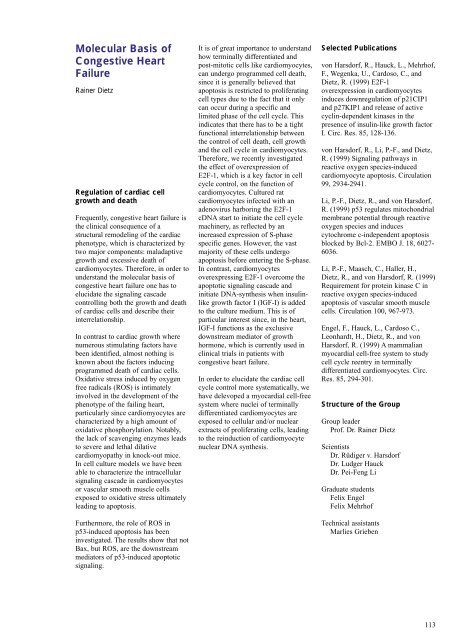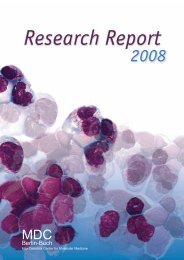You also want an ePaper? Increase the reach of your titles
YUMPU automatically turns print PDFs into web optimized ePapers that Google loves.
Molecular Basis of<br />
Congestive Heart<br />
Failure<br />
Rainer Dietz<br />
Regulation of cardiac cell<br />
growth and death<br />
Frequently, congestive heart failure is<br />
the clinical consequence of a<br />
structural remodeling of the cardiac<br />
phenotype, which is characterized by<br />
two major components: maladaptive<br />
growth and excessive death of<br />
cardiomyocytes. Therefore, in order to<br />
understand the molecular basis of<br />
congestive heart failure one has to<br />
elucidate the signaling cascade<br />
controlling both the growth and death<br />
of cardiac cells and describe their<br />
interrelationship.<br />
In contrast to cardiac growth where<br />
numerous stimulating factors have<br />
been identified, almost nothing is<br />
known about the factors inducing<br />
programmed death of cardiac cells.<br />
Oxidative stress induced by oxygen<br />
free radicals (ROS) is intimately<br />
involved in the development of the<br />
phenotype of the failing heart,<br />
particularly since cardiomyocytes are<br />
characterized by a high amount of<br />
oxidative phosphorylation. Notably,<br />
the lack of scavenging enzymes leads<br />
to severe and lethal dilative<br />
cardiomyopathy in knock-out mice.<br />
In cell culture models we have been<br />
able to characterize the intracellular<br />
signaling cascade in cardiomyocytes<br />
or vascular smooth muscle cells<br />
exposed to oxidative stress ultimately<br />
leading to apoptosis.<br />
Furthermore, the role of ROS in<br />
p53-induced apoptosis has been<br />
investigated. The results show that not<br />
Bax, but ROS, are the downstream<br />
mediators of p53-induced apoptotic<br />
signaling.<br />
It is of great importance to understand<br />
how terminally differentiated and<br />
post-mitotic cells like cardiomyocytes,<br />
can undergo programmed cell death,<br />
since it is generally believed that<br />
apoptosis is restricted to proliferating<br />
cell types due to the fact that it only<br />
can occur during a specific and<br />
limited phase of the cell cycle. This<br />
indicates that there has to be a tight<br />
functional interrelationship between<br />
the control of cell death, cell growth<br />
and the cell cycle in cardiomyocytes.<br />
Therefore, we recently investigated<br />
the effect of overexpression of<br />
E2F-1, which is a key factor in cell<br />
cycle control, on the function of<br />
cardiomyocytes. Cultured rat<br />
cardiomyocytes infected with an<br />
adenovirus harboring the E2F-1<br />
cDNA start to initiate the cell cycle<br />
machinery, as reflected by an<br />
increased expression of S-phase<br />
specific genes. However, the vast<br />
majority of these cells undergo<br />
apoptosis before entering the S-phase.<br />
In contrast, cardiomyocytes<br />
overexpressing E2F-1 overcome the<br />
apoptotic signaling cascade and<br />
initiate DNA-synthesis when insulinlike<br />
growth factor I (IGF-I) is added<br />
to the culture medium. This is of<br />
particular interest since, in the heart,<br />
IGF-I functions as the exclusive<br />
downstream mediator of growth<br />
hormone, which is currently used in<br />
clinical trials in patients with<br />
congestive heart failure.<br />
In order to elucidate the cardiac cell<br />
cycle control more systematically, we<br />
have delevoped a myocardial cell-free<br />
system where nuclei of terminally<br />
differentiated cardiomyocytes are<br />
exposed to cellular and/or nuclear<br />
extracts of proliferating cells, leading<br />
to the reinduction of cardiomyocyte<br />
nuclear DNA synthesis.<br />
Selected Publications<br />
von Harsdorf, R., Hauck, L., Mehrhof,<br />
F., Wegenka, U., Cardoso, C., and<br />
Dietz, R. (1999) E2F-1<br />
overexpression in cardiomyocytes<br />
induces downregulation of p21CIP1<br />
and p27KIP1 and release of active<br />
cyclin-dependent kinases in the<br />
presence of insulin-like growth factor<br />
I. Circ. Res. 85, 128-136.<br />
von Harsdorf, R., Li, P.-F., and Dietz,<br />
R. (1999) Signaling pathways in<br />
reactive oxygen species-induced<br />
cardiomyocyte apoptosis. Circulation<br />
99, 2934-2941.<br />
Li, P.-F., Dietz, R., and von Harsdorf,<br />
R. (1999) p53 regulates mitochondrial<br />
membrane potential through reactive<br />
oxygen species and induces<br />
cytochrome c-independent apoptosis<br />
blocked by Bcl-2. EMBO J. 18, 6027-<br />
6036.<br />
Li, P.-F., Maasch, C., Haller, H.,<br />
Dietz, R., and von Harsdorf, R. (1999)<br />
Requirement for protein kinase C in<br />
reactive oxygen species-induced<br />
apoptosis of vascular smooth muscle<br />
cells. Circulation 100, 967-973.<br />
Engel, F., Hauck, L., Cardoso C.,<br />
Leonhardt, H., Dietz, R., and von<br />
Harsdorf, R. (1999) A mammalian<br />
myocardial cell-free system to study<br />
cell cycle reentry in terminally<br />
differentiated cardiomyocytes. Circ.<br />
Res. 85, 294-301.<br />
Structure of the Group<br />
Group leader<br />
Prof. Dr. Rainer Dietz<br />
Scientists<br />
Dr. Rüdiger v. Harsdorf<br />
Dr. Ludger Hauck<br />
Dr. Pei-Feng Li<br />
Graduate students<br />
Felix Engel<br />
Felix Mehrhof<br />
Technical assistants<br />
Marlies Grieben<br />
113

















